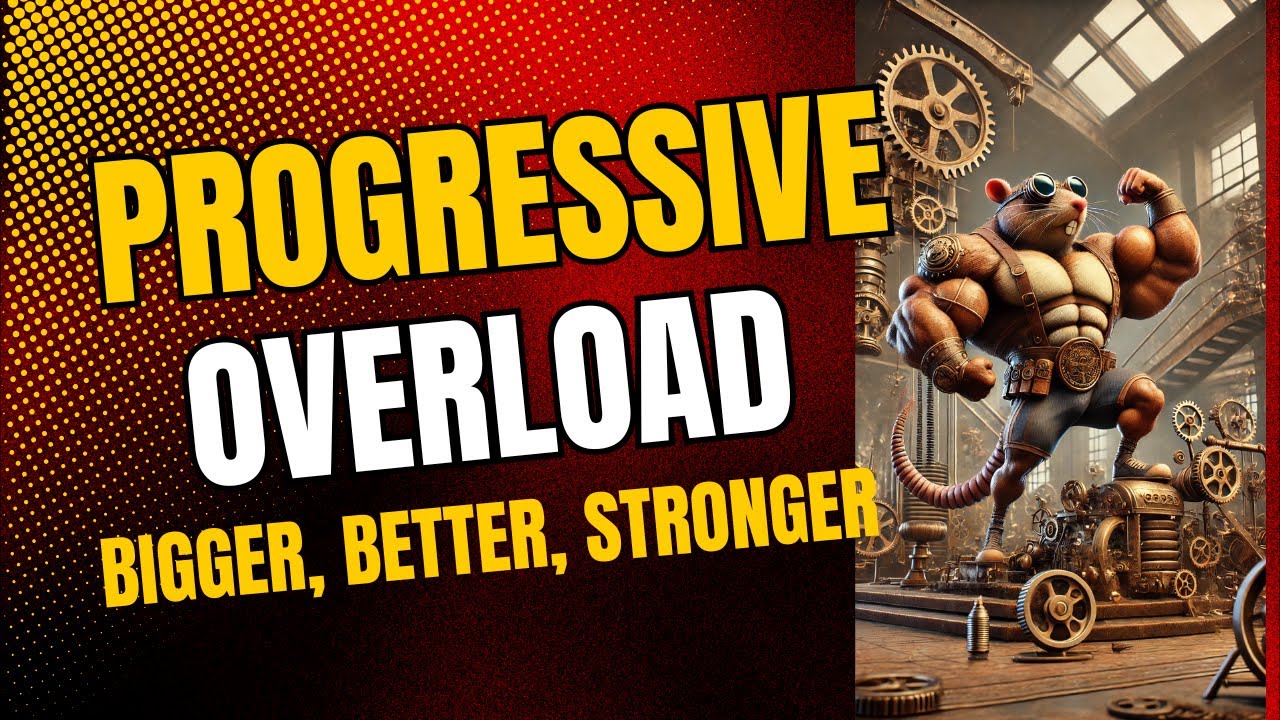A Progressive overload workout is a key tool in todays workout program. The progressive overload principle is a simple but powerful way to get stronger over time. This means slowly making your workouts a bit harder, like adding a little more weight or doing a few extra reps. By sticking to a progressive overload plan, your body keeps getting stronger and adapts to the new challenges.
When following a progressive overload routine, you might add weight, do more reps, or even try harder exercises. For example, if you lift weights, you can increase the weight you lift over time. This type of progressive overload weight lifting helps your muscles grow and gets your body used to lifting more weight.
Many people use progressive overload workouts for different goals, like building muscle, improving endurance, or getting fit. Progressive overload resistance training and progressive overload weight training help make sure that your body doesn’t get stuck at one level. So, what does progressive overload mean? It’s about making small, steady changes to keep getting better and stronger!
Comprehensive Guide to the Progressive Overload Workout Principle.
Introduction to the Progressive Overload Workout Principle.
The progressive overload principle is all about challenging your body so it grows stronger over time. If you always do the same workout, your muscles get used to it and stop growing. By following a progressive overload plan, you slowly add more weight, do extra reps, or increase intensity, making your muscles work harder and get stronger.
A progressive overload routine can help anyone, whether you’re new to exercise or already strong. With progressive overload workouts, your body keeps adapting to the new challenges, helping you build muscle, get more endurance, and reach your fitness goals. Using a progressive overload routine for weightlifting or cardio means you won’t get bored or stuck; you’ll always see progress.
So, what does progressive overload mean? It means pushing yourself just a little more each time, like adding extra weight or a few more reps. Progressive overload resistance training or progressive overload weight lifting helps your muscles stay challenged and grow. When you use the principle progressive overload, your body works to keep up, making you stronger and fitter!
Understanding the Progressive Overload Workout Principle.
Define Progressive Overload.
The progressive overload principle works by gradually pushing your body to do more each time. This can be done in several ways, like adding a little more weight or doing a few more reps. By following a progressive overload plan, your muscles stay challenged and keep growing stronger as they adjust to the new demands.
- Adding weight: Lifting heavier over time.
- Increasing repetitions: Doing more reps within the same set.
- Increasing intensity: Making exercises more challenging (e.g., jumping instead of stepping).
- Reducing rest time: Taking shorter breaks to keep muscles engaged.
Whether you’re interested in progressive overload weight lifting or progressive overload resistance training, the key is to push your body slightly more each time you work out. When your muscles work harder, they adapt and grow stronger, which is the foundation of the progressive overload workout principle.
How the Principle Applies Across Workouts.
The beauty of the progressive overload principle is that it can be used with almost any exercise. Whether you’re lifting weights, doing push-ups, or even running, a progressive overload plan keeps your body challenged. With a progressive overload routine, you can add weight, increase reps, or take shorter rests, helping your muscles grow stronger. So, what does progressive overload mean? It’s all about making small changes that keep you improving, no matter the type of workout!
- Weight lifting: Lifting heavier weights builds muscle size and strength.
- Resistance training: Using resistance bands or body weight to increase muscle endurance.
- Bodyweight exercises: Adding reps or modifying moves like push-ups to make them more challenging.
By following a progressive overload workout routine for each type of exercise, you’ll see steady improvements in strength, endurance, and muscle tone. This means that with each workout, your body keeps adapting to new challenges, becoming stronger and more capable. The progressive overload principle works for everything from weightlifting to cardio, helping you reach your fitness goals over time.
Core Benefits of a Progressive Overload Workout Routine.
A well-designed progressive overload routine offers many benefits, helping you get stronger and fitter faster. By following the progressive overload principle, you keep challenging your body, which helps you avoid hitting a fitness plateau. With each workout, you build more strength, endurance, and muscle tone, making it easier to reach your goals.
One great thing about progressive overload workouts is that they work for all fitness levels. Whether you’re doing progressive overload weight lifting or progressive overload resistance training, you’re gradually increasing your challenge in a safe, steady way. This approach helps you stay motivated and see real progress, which is what the principle progressive overload is all about.
Muscle Growth and Strength Development.
The main benefit of the progressive overload principle is building muscle and gaining strength over time. When you introduce a new challenge, like lifting heavier weights, your muscles respond by growing stronger. This process gradually leads to noticeable changes, making your muscles bigger and more powerful as they adapt to each new challenge.
Following a progressive overload routine helps ensure continuous improvement in your workouts. Progressive overload weight lifting is one of the best ways to build strength and muscle, whether you’re a beginner or advanced. By gradually increasing weight, reps, or intensity, the principle progressive overload helps you keep progressing toward your fitness goals steadily and safely.
Improved Endurance and Cardiovascular Health.
The progressive overload principle isn’t only for building muscle; it also improves endurance. By gradually increasing reps or reducing rest time, you teach your muscles to keep working for longer. This helps in activities like running, cycling, and even progressive overload resistance training, where endurance is key to keeping muscles active through extended workouts.
A good progressive overload routine for endurance means pushing a bit more each time you train. You might add extra reps or shorten your rest breaks to keep your muscles engaged. With a steady progressive overload plan, your endurance builds, helping you stay stronger for longer periods, whether you’re in the gym or doing outdoor sports.
Enhanced Flexibility and Mobility.
The progressive overload principle also applies to flexibility and mobility exercises. By gradually increasing the depth or hold time of stretches, you improve your body’s range of motion. Over time, this helps with joint health, balance, and reduces the risk of injury. Adding progressive overload to stretching routines creates a well-rounded fitness program that enhances both strength and flexibility.

How to Start a Progressive Overload Workout Routine for Beginners.
If you’re new to fitness, the progressive overload workout principle is a safe and effective way to start building strength. Follow these steps to get started with a beginner-friendly progressive overload workout routine.
Step-by-Step Guide for Beginners.
Start with Light Weights and Fewer Reps
Begin with a weight that feels comfortable to lift for about 8-10 reps. This helps you get used to the movement and learn the proper form. Good form is key to preventing injuries and making sure you’re working the right muscles.
Gradually Increase Weight or Reps.
Every week, try to add a little more weight or do a few extra reps. For instance, if you start lifting 5 pounds, aim for 8 pounds after a week or two. These small increases help build strength over time without overwhelming your body.
Track Your Progress.
Keep a record of the weights, reps, and sets you complete during each workout. Tracking your progress lets you see how far you’ve come and when it’s time to increase the challenge in your progressive overload workout plan.
Take Rest Days.
Rest days are essential for muscle recovery and growth. Make sure to take breaks between workouts to avoid overuse injuries. A balanced progressive overload workout routine includes rest, allowing your muscles time to repair and prepare for the next session.
Sample Beginner Progressive Overload Workout Plan.
Here’s a simple beginner progressive overload workout plan that focuses on major muscle groups. Start with light weights and follow the increase schedule each week.
| Week | Exercise | Sets | Reps | Weight Increase |
|---|---|---|---|---|
| 1 | Squats | 3 | 10 | Bodyweight |
| 2 | Squats | 3 | 10 | Add 5 lbs |
| 3 | Squats | 3 | 12 | Add 5 more lbs |
| 4 | Squats | 3 | 15 | Maintain weight |
You can follow a similar progression for other exercises, such as lunges, push-ups, and bicep curls. This progressive overload workout plan helps build strength safely and ensures that you’re always working a little harder each week.
Importance of Gradual Progression.
As a beginner, it’s crucial to increase weight or reps slowly to avoid injury. By following a progressive overload workout plan, you allow your body time to adapt. The goal is steady progress, not rushing to lift heavy weights immediately. Over time, this gradual increase will make you stronger and more capable, setting a strong foundation for future workouts.
Progressive Overload Workout Routine for Intermediate Lifters.
Once you’ve built a foundation, moving to an intermediate progressive overload routine helps you keep progressing. As an intermediate lifter, your body has adapted to basic exercises, so adding more intensity is essential. This stage of a progressive overload workout plan focuses on using heavier weights, performing complex movements, and reducing rest time to keep challenging your muscles.
Intermediate lifters can also try advanced techniques, like supersets, to boost progress. Supersets involve doing two exercises back-to-back without rest, keeping muscles under tension longer and building endurance. These types of progressive overload workouts help push your body harder and make it stronger over time.
Other techniques, like drop sets and tempo changes, make a progressive overload routine more effective. Drop sets involve lowering weight when muscles get tired, so you can keep going even after reaching fatigue. Tempo changes, like slowing down a lift, increase the time muscles stay under tension, making progressive overload weight lifting more challenging and effective.
Sample routine for intermediate lifters.
Week 1-2..
- Squats: 3 sets of 12 reps, moderate weight.
- Deadlifts: 3 sets of 8 reps, moderate weight.
- Superset: Push-ups (12 reps) and rows (12 reps) for 3 sets, 30-second rest
- Add 5-10% more weight each week or reduce rest time to maintain intensity,
Using a combination of these advanced techniques in your progressive overload workout routine helps keep your body guessing, which encourages strength and endurance growth.

Building a Progressive Overload Workout Plan.
Creating a personalized progressive overload workout plan can help you target specific goals. A balanced plan typically includes weight lifting, resistance exercises, and even some cardio for comprehensive fitness. Each element of the plan should be adjusted over time to keep muscles working at their maximum capacity.
Steps to build your plan:
- Set Clear Goals.
Determine whether your main goal is to build muscle, improve endurance, or increase flexibility. If your goal is to build muscle, focus on progressive overload weight lifting. For endurance, add higher reps and longer sessions. - Choose Your Exercises.
A good progressive overload workout routine includes a mix of compound exercises (like squats and bench presses) and isolation exercises (like bicep curls). Compound movements engage multiple muscles, which is ideal for building overall strength. - Track Your Progress.
Logging each workout in a notebook or app can help you see when it’s time to increase weight, reps, or sets. Tracking keeps you focused on your goals and ensures you’re following the progressive overload principle. - Add Variation Over Time.
To prevent plateaus, change your exercises every few weeks. For example, if you’ve been doing standard push-ups, try incline push-ups or add weights. This keeps the progressive overload workout plan challenging and effective.
Sample 4-week plan:
| Week | Exercise | Sets | Reps | Progression |
|---|---|---|---|---|
| 1 | Bench Press | 3 | 10 | Moderate weight |
| 2 | Bench Press | 3 | 12 | Add 5 lbs |
| 3 | Incline Push-Ups | 4 | 10 | Increase reps by 2 |
| 4 | Decline Push-Ups | 4 | 12 | Increase reps by 2 or add weight |
A progressive overload workout plan like this provides variety while keeping the focus on gradual improvement. Adjust each exercise based on how your body responds, and ensure you’re challenging yourself each week.
Applying the Progressive Overload Principle in Various Workouts.
The progressive overload principle is versatile and can be applied across different types of workouts, from weight lifting to cardio to flexibility exercises. Here’s how to use progressive overload in each type of training:
Weight Lifting.
For progressive overload weight lifting, focus on increasing the weight gradually. Exercises like squats, deadlifts, and bench presses are perfect for adding more resistance. Start with a weight you can lift for 8-10 reps and add small amounts as it becomes easier. This approach helps build muscle mass and strength over time.
Cardio:
In cardio exercises, you can use the progressive overload principle by running longer distances or increasing speed. For example, if you usually run for 20 minutes, try adding 5 minutes each week. You could also increase the intensity by adding hills or intervals. This keeps your heart rate up and improves cardiovascular endurance.
Flexibility and Mobility.
To apply progressive overload to flexibility, gradually increase the depth or hold time of your stretches. For example, in a hamstring stretch, try reaching a bit further each week or holding the position for longer. This approach improves flexibility and joint health over time, following the progressive overload workout principle.
Progressive overload workouts tailored to these different types of exercises make your fitness routine well-rounded, ensuring you build strength, endurance, and flexibility.
Safety in Progressive Overload Workouts.
While progressive overload is highly effective, it’s essential to prioritize safety. Increasing weight or intensity too quickly can lead to injuries, especially in weight lifting. Following proper weight lifting techniques helps protect muscles and joints.
Tips for Safe Progressive Overload Workouts.
Prioritize Form.
Before you start adding weight, focus on using the correct form. Practicing each movement slowly at first helps you build good habits. This way, you can be sure that you’re doing the exercise safely and effectively.
Poor form can lead to injuries, so it’s important to get it right. Once you’re confident in your technique, you can start increasing weight gradually. Good form will protect your muscles and joints while helping you get the most out of each exercise.
Listen to Your Body.
It’s normal to feel tired and sore after a workout, but pain is different. If you experience sharp or unusual pain, stop and check your form. Sometimes, a small change in technique can prevent pain and make the movement safer.
Listening to your body is essential for a safe progressive overload workout routine. Taking time to notice how you feel during and after workouts can help you avoid injuries and make steady progress.
Take Rest Days.
Rest days are just as important as workout days because they allow your muscles to recover and grow. Including rest days in your progressive overload workout plan gives your body time to repair and prepare for the next challenge.
Taking time off prevents overtraining, which can lead to exhaustion or injuries. When you rest, your body becomes stronger, helping you handle the next increase in weight or intensity with confidence.
Focusing on safety ensures that your progressive overload workouts remain effective and sustainable in the long run.

Avoiding Plateaus with Progressive Overload Workouts.
Even with consistent effort, many people hit a plateau where progress stalls. Plateaus happen when muscles adapt fully to a workout, making it difficult to keep building strength or endurance. Fortunately, the progressive overload workout principle provides several strategies to overcome these sticking points.
Signs of a Plateau.
Signs of a plateau include not seeing improvement in strength or endurance over time. If you find it hard to add more weight or reps, it may mean your body has adapted to the progressive overload routine. Plateaus can be frustrating, but they show that it’s time to change up your progressive overload workouts to keep progressing.
Another sign of a plateau is feeling less soreness after your workouts. This could mean your muscles aren’t being challenged enough. Adjusting your progressive overload plan by adding weight, reps, or trying new exercises can help push your body past the plateau and get you back on track with your fitness goals.
Strategies to Break Through Plateaus.
One way to break through a plateau is to change exercises regularly. Switching up your progressive overload routine challenges your muscles in new ways, helping them grow and adapt. Trying different movements in your progressive overload workouts keeps things fresh and avoids boredom, helping you keep improving. This simple change can make a big difference in your progress and get you back on track with the progressive overload principle.
Switching up exercises helps engage muscles in new ways. If you’ve been doing bench presses for weeks, try switching to dumbbell presses or incline presses. This slight variation in movement forces muscles to adapt again, helping you continue progressing.
Add Intensity with Supersets and Drop Sets.
Supersets involve performing two exercises back-to-back with no rest in between. For example, combine a bench press with push-ups. Drop sets involve reducing the weight immediately after reaching fatigue, allowing you to push muscles further. These techniques keep muscles engaged longer, helping break through plateaus.
Adjust Rest Times.
Shortening rest periods between sets keeps your muscles working and increases intensity. For example, if you usually rest 90 seconds, try cutting it to 60 seconds. This change keeps your body from adapting fully, providing a new challenge for your muscles.
By implementing these strategies, you can overcome plateaus in your progressive overload workout routine and continue making steady gains.
Common Mistakes to Avoid in Progressive Overload Weight Training.
Following the progressive overload workout principle is highly effective, but mistakes can lead to injuries or stalled progress. Here are some common mistakes to watch for and tips on how to avoid them.
Overtraining Without Recovery.
While increasing intensity is good, muscles need time to recover. Overtraining happens when you push muscles too hard without giving them time to heal, which can lead to fatigue, soreness, or even injury. Include rest days in your progressive overload workout routine to allow for proper recovery.
Increasing Weight Too Quickly.
One of the biggest risks in progressive overload weight training is jumping to heavier weights before your body is ready. Progressive overload is about small, steady increases. Adding too much weight too soon can lead to strained muscles or joint injuries. Instead, focus on gradual improvements—adding 2.5 to 5 pounds at a time is often enough to keep progressing safely.
Neglecting Form in Favor of Heavier Weights.
Using proper weight lifting techniques is important to avoid injuries and keep progressing. If your form gets shaky as weights get heavier, it’s a sign to focus on technique. Good form not only protects your joints and muscles but also makes sure you’re targeting the right areas effectively.
Avoiding mistakes in your progressive overload routine helps make it safer and more effective. By focusing on proper form, you can continue with progressive overload weight lifting without setbacks, allowing for steady improvement. This keeps you on track with your fitness goals and supports long-term progress.

Importance of Rest and Recovery in a Progressive Overload Routine.
Rest and recovery are as important as the workout itself. During rest, muscles repair and grow stronger, preparing them for the next challenge. Without proper rest, you risk overtraining, which can lead to fatigue, injuries, and slower progress.
Why Muscles Need Rest to Grow.
Progressive overload workouts cause tiny tears in muscle fibers. During rest, your body repairs these fibers, making them stronger and more resilient. If you don’t allow time for recovery, your muscles can’t repair fully, which affects your progress.
Scheduling Rest Days in Your Progressive Overload Workout Routine.
Aim to rest each muscle group for at least 48 hours between workouts. For example, if you work on your upper body on Monday, wait until Wednesday to work it again. By rotating muscle groups, you can keep exercising while giving each group the rest it needs.
Role of Nutrition and Hydration in Recovery.
Eating a balanced diet with enough protein helps muscles repair and grow. Staying hydrated is also crucial, as water supports muscle function and aids in recovery. Nutrition and hydration are key components of any progressive overload workout plan.
Including rest and proper nutrition in your progressive overload routine helps you maximize gains and reduces the risk of injury, ensuring that you stay on track with your fitness goals.
Creating a Structured Progressive Overload Exercise Routine.
A well-planned progressive overload workout routine should include a variety of exercises, target different muscle groups, and balance strength and endurance. Here’s how to create a structured plan that covers all aspects of fitness.
Sample Weekly Workout Schedule.
Weekly Workout Plan:
- Monday: Chest and Triceps – Bench Press, Push-Ups, Tricep Dips
- Tuesday: Lower Body – Squats, Lunges, Leg Press
- Wednesday: Rest Day – Active recovery with light stretching
- Thursday: Back and Biceps – Deadlifts, Pull-Ups, Bicep Curls
- Friday: Core and Flexibility – Planks, Russian Twists, Yoga Stretches
- Saturday: Cardio and Endurance – Running, HIIT intervals
- Sunday: Rest Day – Full rest or light activity
Tip: Balance compound exercises (work multiple muscle groups) and isolation exercises (target one muscle group) to maximize gains.
Compound exercises like squats and bench presses work multiple muscle groups and are essential in a progressive overload workout routine. These should be the foundation of your workout plan. Isolation exercises, like bicep curls, target specific muscles, which helps with muscle definition and balance.
Tips for Long-Term Success and Consistency.
Consistency is key to seeing results with the progressive overload workout principle. Stick to your routine, track your progress, and make adjustments as needed. Remember that small, consistent increases will lead to big changes over time.

Using Progressive Overload for Flexibility and Mobility Training.
While the progressive overload principle is commonly associated with weight lifting, it can also improve flexibility and mobility. By gradually increasing the intensity or duration of stretches, you can enhance joint mobility and overall flexibility, which contributes to injury prevention and better performance in other exercises.
How to Apply Progressive Overload to Flexibility.
In flexibility training, the progressive overload principle means gradually holding stretches longer or going deeper. For example, when stretching your hamstrings, you can start by holding for 15 seconds. Each week, add a few more seconds until you reach 30 seconds to safely improve flexibility.
Using a progressive overload routine for stretching helps your muscles adapt slowly without strain. By adding a little more time or depth, your body becomes more flexible over time. This steady progressive overload plan makes flexibility training safe and effective, helping you reach new levels in your stretching goals.
Building a Progressive Overload Routine for Mobility,
Mobility exercises focus on improving range of motion and are essential for joint health. To use progressive overload in mobility, you can gradually increase the range of motion in exercises like lunges or squats. For instance, aim to go slightly deeper in your lunges each week, which challenges your muscles and joints without causing strain.
Benefits of Progressive Overload in Flexibility Training.
Using the progressive overload principle in flexibility training improves your body’s overall functionality. Enhanced flexibility and mobility reduce the risk of injury, help with balance, and support better posture. A well-rounded progressive overload workout routine that includes flexibility training allows you to move more freely, which is valuable for both everyday activities and athletic performance.
Tracking Progress in a Progressive Overload Weight Lifting Program.
Keeping track of your progress is essential in any progressive overload workout routine. Monitoring each increase in weight, reps, or time spent stretching can help you stay focused and motivated. Here’s how to track progress effectively and why it’s so beneficial.
Using a Workout Journal or App.
Recording each workout helps you see patterns and improvements over time. In your journal or app, write down the exercise, weight, reps, sets, and any notes on how challenging it felt. When you look back, you’ll be able to see when it’s time to increase difficulty in your progressive overload workout plan.
Knowing When to Adjust Weights, Reps, or Duration.
When you find that your current weight or number of reps feels easy, it’s a signal that it’s time to adjust. In a progressive overload workout routine, aim to increase weight by 5-10% or add 1-2 more reps to each set when you reach this point. These small adjustments help ensure that your muscles are always being challenged.
Motivation and Goal-Setting in Progressive Overload Workouts.
Tracking progress provides a sense of accomplishment and helps set future goals. For instance, if you’re aiming to bench press 150 pounds, seeing yourself progress from 100 to 125 pounds is motivating. Setting achievable goals based on your current performance makes it easier to stick with the progressive overload workout principle.
Progressive Overload Comparison Between Beginners and Experienced Lifters.
The progressive overload workout principle works for everyone, but beginners and experienced lifters approach it differently. Here’s how each group can optimize their routines for maximum benefit.
Beginners.
Beginners can often make quick progress with the progressive overload principle as their bodies adapt to new exercises. A progressive overload routine for beginners should focus on simple, compound movements like squats, push-ups, and rows. These exercises work multiple muscles at once, building a strong foundation.
By mastering basic movements, beginners can safely increase weights and reps over time. This approach helps build muscle memory, making progressive overload weight lifting easier and safer in the future. Starting with the basics allows for steady progress without overloading the body too soon.
Experienced Lifters.
For experienced lifters, progress often slows because their muscles have adapted to the foundational exercises. At this level, a progressive overload workout plan involves advanced techniques like adding variations (e.g., incline bench presses instead of flat), using drop sets, or increasing time under tension. These changes keep muscles challenged even when weight increases are smaller.
Adjustments for Each Group in Progressive Overload Workouts.
Beginners should focus on form and gradually increase weights, while experienced lifters can use more complex training techniques to stimulate further growth. The principle of progressive overload remains the same—small, consistent increases over time—but the approach is tailored to each fitness level.

Benefits of a Progressive Overload Workout Routine for Long-Term Fitness Success.
The progressive overload workout principle is not just a short-term strategy; it’s designed for long-term fitness success. By gradually increasing the challenge, you create a routine that keeps muscles growing, endurance improving, and flexibility increasing. This makes progressive overload one of the most reliable methods for achieving and maintaining peak fitness.
How Progressive Overload Supports Lasting Results.
Progressive overload workouts help avoid the dreaded “fitness plateau” by ensuring your muscles are always working harder. This approach to fitness leads to steady gains, which are more sustainable than quick-fix solutions. A well-planned progressive overload workout routine means you’ll continue making progress even after months or years of training.
Psychological and Physical Benefits of Gradual Improvement.
Small increases in weight or intensity provide a sense of achievement and motivate you to keep going. Physically, each increase means your muscles and cardiovascular system are adapting and growing stronger. This combination of physical and mental benefits makes the progressive overload workout principle effective for people looking to make fitness a lifelong habit.
Why Progressive Overload is Essential for Sustained Fitness.
Consistent improvement is key to staying motivated and engaged with your workout plan. Following a progressive overload workout plan prevents boredom and keeps you invested in your fitness goals. Over time, this steady progress leads to a stronger, healthier body and a greater sense of personal accomplishment.
Conclusion: Achieving Fitness Goals with the Progressive Overload Principle.
The progressive overload principle is a great way to get fitter and stronger. By challenging your muscles a little more each time, you help them grow. A good progressive overload routine keeps you improving and makes it easier to reach your goals.
With a progressive overload plan, you can adjust workouts for any fitness level. Whether lifting weights, doing cardio, or stretching, a progressive overload routine for each exercise helps you make steady progress. Adding a bit more weight, reps, or making exercises harder builds a stronger, more flexible body.
The principle progressive overload keeps you moving forward and avoids plateaus. Progressive overload workouts always challenge your muscles, helping you improve over time. This approach keeps you on track and helps you reach peak fitness step by step.
Check Out Our YouTube Channel!
Expert Tips & Tricks.
Fitness Culture.
Nutrition Guidance.
Workout Plans.





